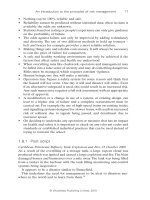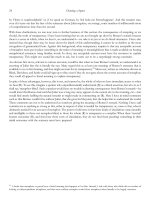Benchmarking the Strategic Management of Technology PHẦN 2 potx
Bạn đang xem bản rút gọn của tài liệu. Xem và tải ngay bản đầy đủ của tài liệu tại đây (1.09 MB, 10 trang )
Probing the
database for
more
insights
into
the
roles
of
the
CTOs,
we
again
find
Japanese
chief
technology
officers
more
involved
in
overall
corporate
strategy.
This
is
not
looking
inward
to
technology
but
outward
toward
the
corporation
as
a
whole.
As
Figure
8
demonstrates,
significant differences
also
are
evident
in
the
Insert Figure
8.
extent
to
which
the
corporate
CTO
provides
direction
for technology
development
at
the
business-unit
level.
These
influences include
such
elements
as
top-down
perspectives
about
prioritization,
standards,
staffing considerations,
quality
control
for
technology,
global
competitive
analysis
on
the
technological
dimensions
of
the
firm. And
again
we
find
in
ranking
that
in
Japan
more
powerful
CTOs
are
more
prevalent
than
in
Europe,
and
significantly
moreso
than
in
the
United
States.
I
believe
that
many firms
are
structured
inappropriately
at
the
top
of
their
own
technological
endeavors
to
provide
a
centrality
of
focus,
direction
and
leadership,
particularly
with
respect
to
strategic
linkage.
I
am
not
arguing
here
about
questions
of
centralized
or
decentralized
management
of
R&D,
nor
of
how
technology
must
be
tied
effectively
into
individual
product
lines.
I
am
talking
instead
of
how
the
firm
creates
a
strategic
vision
of
which
technologies
it
needs,
how
the
technology
is
to
meet
overall
corporate
objectives
and
corporate
priorities,
how
the
technology
is
to
be
developed
and/or acquired,
and how
technology
development
across
the
firm
can
benefit
from
coordination
and
synergy.
Those objectives
are
far
more
likely
to
be
fulfilled
if a
senior
(e.g.,
chief)
technology
officer
who
is
capable
of
tying
technology
to
overall
corporate strategy
is
working
at
or
near
the
board
level
of
the
firm.
Budgeting
for
R&D
One
obviously
cannot
talk
about
management
without
talking
about
budgets.
Budgets
critically
reflect
strategy.
Earlier
I
emphasized
some
differences
between
the
corporate
and
the
business-unit
levels
of
the
firm. Now,
Figure
9
presents for
the
overall
sample
of
companies the
percentile
breakdown
of
R&D
spending
at
the
corporate
level,
where
an
orientation
toward
research
spending
is
evident, versus
the
business-unit
level,
where
spending
for
development
Insert
Figure
9.
dominates.
Significant
regional
differences
do
exist, partly
reflecting
different
industry
compositions
of
these
regions.
Japanese
companies overall
allocate
far
more of
corporate-level
budgets
to
development
(44
percent
vs.
U.S.
36
percent
and
Europe
33
percent)
and
far
less to
research
(32
percent
vs.
U.S.
42
percent
and
Europe
49
percent)
than
other
regions,
but
this
is
changing.
Corporate-level
support
of
current product
and
process
technology
does
account
for
over
20
percent
of
its
budget.
Clearly,
as we
move from
the
corporate
to
the
business-unit
level,
near-term
support
of both
product
and
7
process
technology
rises
markedly,
as
does
near-to-intermediate
term
development
spending.
The
percent
of
budget
allocated
to
research
is
quite
small
at
the
business-unit
level.
Note
that
these
numbers
do
not
serve
as
a
model
for
any
particular
firm
to
copy
because they
are
really
averages
across industries.
A
corporation
must
analyze
industry-specific
data
to
benchmark
R&D
budgets.
For
example,
two
different
industry
breakouts
are
displayed
in
Figure
10
just
to
emphasize
how
Insert
Figure
10.
dramatically
different
these
percentile
scores
are
at
the
industry
level.
Both
at
the
corporate
and
the
business-unit
levels
two
quite
different
industries
chemicals
and
materials
on
the one
hand
and
electronics
on
the
other
employ
very
different
patterns
of
R&D
expenditures.
Benchmarking
how
a
firm
ought
to
be
spending
its
R&D
money
is
inherently
dangerous,
especially
if
carried
out
against dissimilar
firms.
Specifically
a
company
ought
to
look
to its
own
industrial
base
and
on
trying
to
develop
ways
of
comparing
what
its
competitors
are
doing,
how
they
are
spending
their
money,
and
how
they
are
prioritizing
their
expenditures.
Spending
patterns
by
industry
turn
out
to
be
very
different.
Decentralizing
Control
Except
Japan
Beyond
the
issue
of
budget
is
what
ought
to
be
the
related
consideration
of
control.
Here
we
found
quite
a
surprise.
Industry
observers
have
long
known
that
U.S.
companies
are
more
diversified,
and
therefore
have
tended
to
be
more
decentralized,
than
comparable
European
and
Japanese
firms.
But
it
is
now
very
clear
from
the
data
that for
five
or
six
years
the
major
companies
in
the United
States
have
been
moving
even
more
heavily towards
further
decentralized
control
of
both
research
and
development.
Control
of
both
R&D
budgets
and
activities
has been
moving
rapidly
from
the
corporate
level
to
the
divisional
and
business-unit
level
of
the firm.
Chester
warns
that
"a
research
department
that
reports
to
a
business
unit
rather
than
a
corporate
laboratory
will
develop
a
shorter
time
horizon,
and
will
limit
its
focus
to
the
charter
of
the
business
unit."
5
Much
to
our
surprise the
same
pattern
of
change
is
not
occurring
in
Japan,
nor
in
Europe
to
the
same
extent.
Consider
the
data
shown
in
Figure
11.
For
Insert
Figure
11.
research,
almost
all
Japanese
firms
continue
to
be
moving
control
upward
in
the
firm
away
from
the
business-unit
level
toward
more
centralized
control
at
the
corporate
level.
"At
Hitachi,"
for
example,
"control
over
R&D
is
shifting
from
individual
profit
centers
to
administrative
divisions
with
broader
access
to
market
research".
6
This
is
clearly
not
what
is
occurring
for research
in
the
United
States
and
Europe.
Of
course,
many
Japanese
companies
are
in
the
process
of
playing
"catch-up"
in
research,
rapidly
increasing
their
expenditures
after
years
of
neglect.
Rapid
increases
in
any
effort
are
often
seen
as
most
easily
carried
out
8
centrally,
providing
one
possible
explanation
for
the
increasing
Japanese
corporate-level
control
of
research.
But,
coupled
with
other
clues
already
discussed,
this
trend
may
well
reflect
a
greater
Japanese
sensitivity
to
the
corporate
strategic
nature
of
research
direction.
I
believe
that
these
control
changes take
place
in
R&D
organizations
in
cycles,
especially
for
research, with
about seven-to-ten
years
for
the
half-cycle.
In
the
U.S.,
my
opinion
is
we
are
nearing
the
end
of
the
half-cycle
of
decentralization
of
R&D
control,
i.e.
moving
control
of
budgets
and
programs
down
to
the
divisional
or
business-unit
level.
I
expect
that
within
a
few
years
U.S.
companies
will start
to
recentralize
control
of
R&D
as
they
find the
problems
of
technological
blindsiding
and
short-term
investment
management
begin
to
dominate
competitive
issues
at
the
business-unit
level.
American
firms
will
again
begin
to
make
longer-term
investments,
perhaps
by
creating
corporate
centers
of
excellence
in
areas
of
core
technology,
putting
more
money
into
longer-term
corporate
research.
I
think
that
will
begin
to
happen
within
the next
three
years.
What's
interesting
is
that
the
current
pattern
in
the
U.S.
is
not
occurring
elsewhere.
The
rest
of
the
world
may
just
be
out
of
phase
or
perhaps
merely
behaving
more
rationally.
Similar
distinctions
are
arising
in
development.
We
again
observe
in
Figure
11
heavy
momentum
in
the
U.S.
towards
decentralized
control
of
development.
In
Europe
and
Japan
it
is
about
50-50
as to
whether
control
of
development
work
is
shifting
upward
or
downward.
United
States
companies
are
clearly
differentiating
themselves
in
moving
toward
the
business
unit.
We
all
know
the
benefits
of
decentralized
control
in
terms
of
responsiveness
to
customers
and
short-term
ability
to
implement
changes
in
current
product
lines.
These
moves create
a
quandary
in
regard
to
the
linkage
concept that
I
have
emphasized:
they
provide
tighter
linkage
between
technology
and
business-unit
tactics,
while
weakening
possible
ties
at
the
corporate
strategic
level.
These
changes
will
indeed
make
U.S.
firms
more
competitive
in
short-term
performance,
bringing
the
locus
of
R&D
closer
to
the
end-customers
being
served.
But
the problem
with
business-unit
control
of
R&D
is
that
the
firms
eventually
stop
investing
in
longer-term
R&D,
the
strengthening
of
core
capabilities
and
the
creation
of
new
core
strengths.
Consequently,
the
trend
in
the United
States
toward
decentralized
control
may
well spell
future
technological
and
competitive
disaster,
if
continued
much
longer.
Searching
for
Leverage
Beyond
the
importance
of
linkage
to
company
results
is
the
concept
of
"leverage".
The
survey
data
on
industry's
moves
to
the
outside
world
in
search
of
relevant
technology,
illustrated
in
Figure
12,
are
rather
profound.
Shifts
have
Insert
Figure
12.
been
occurring
rapidly
in
the
extent
to
which
companies
see
themselves
as
increasingly
and
strongly
reliant
on
external
sources
of
technology.
For
example,
in
his
1992
MIT
address
president
Lutz
of
Chrysler
made
the
important
point
that
9
in
its
Liberty
program,
as
well
as
in
other
projects,
Chrysler
had
shifted
substantially
from
predominantly
internal
management
of
R&D
efforts
to
the
extensive
use of
outside
partners.
The
anticipated
changes
here
continue
over
the next
three
years.
Note
in
the
figure
the
dramatic
difference
in
positioning
among
Japanese,
European
and
American
companies
with
respect
to
their
historic dependence
on
external
sources
of
technology, their
current
reliance
and
their
anticipated
future
position.
Japanese
firms
clearly
see
themselves
as
reliant
and
dependent
upon
outsiders
far
more
than
does
anyone
else.
Lutz
describes
Chrysler,
in
this
domain,
as
becoming
more
Japanese
in
management
style,
creating
strong
ties
to
outside
vendors
and
suppliers,
even
of
technology.
He
labeled
this
a
"virtual
enterprise",
with
the firm's
effective
boundaries
extended
to
include
the
capabilities
of
many
collaborators.
The
Industrial
Research
Institute's
annual
forecast
confirms
this
trend,
showing
that
47
percent
of
the
U.S.
firms
that replied
expect
increased
participation
in
alliances
and
joint
ventures,
with
18
percent
expecting
to
increase
their
licensing
from
others.
7
One
of
the
more
prominent
recent
examples
is
the
announced
controversial
billion-dollar,
long-term
research
agreement
between
Scripps
Research Institute
and
Sandoz
Pharma,
8
since
revised
downward
in
its
terms.
9
In
general,
the
OECD
indicates
a
13-fold
increase
in
the
creation
of
multinational
inter-firm
technological
agreements
from
1973
to
1988,
with
more
than
half
being
joint
ventures
and
joint
R&D.
10
This
situation
can
be
described
in
two
very
different
sets
of
terms.
Reliance
or
dependence
upon
"others"
has
a
clearly negative
connotation.
"Others" may
limit
access
to
their
best
technology.
Others
may
exact
control
of
you due
to
your dependence.
Others
may perform
contrary
to
your
expectations
or
desires.
But
this
situation
can
also
be
labeled
by
the
more
positive
but
risk-
inferring
term
of
leveraging.
Internal
technological
resources
can
be
leveraged
by
effective
access
to,
and
use
of,
external
technology.
The
Japanese
seem
to
be
in
the
vanguard
of
this
leveraging
movement.
Sixty
percent
of
all
major
Japanese
companies expect
to be
highly
dependent
upon
external
technology
sources
three
years
from
now,
compared
with
25
percent
just
three
years
ago.
European firms
expect
only
half
as
much
external
dependency
over
the
next
three
years.
Many
companies
have
not
yet
adequately
dealt
structurally
from
a
managerial
point
of
view
with
this
new
situation.
How
does
a
firm
manage
the
acquisition
of
technology
being
supplied
primarily
by
companies
not
under
its
own
control?
It
is
difficult
enough
to
try
to
control
and
manage
internal
R&D
staffs,
but
to
be
able
to
manage
dependencies
upon
another
organization's
R&D
efforts
is an
order
of
magnitude
more
difficult.
I
believe
that
companies
are
going
to
find
themselves
increasingly
in
trouble
due
to
failures
arising
from
the
management
of
external
sources
of
technology.
This
is
not
to
say
that
firms
shouldn't
be
moving outward.
This
is
to
argue
the
need
for
worrying
about
how
overall
management
systems
and
staffing
are
being
geared
up
for
management
and
integration
of
external
technology
sources.
The
increasingly
central
control
of
R&D
evidenced
by
Japanese
10
companies
in
Figure
11
may
be a
response
in
part to
requirements
generated
by
external
sourcing.
Companies
need
to
develop
new and
critical
skills
inside
to
be
able
effectively
to
interface
with and
manage
technology
acquisition
outside.
Outsourcing
cannot
mean
denuding
internal
capabilities
or the
process
will
fail.
Looking
for
Technology
Turning
more
broadly
to
the
question
of
sources
of
technology,
from
where
does
a
major
company's
technology
come?
We
again
differentiate
the
research
side
of
the
firm
from
development
activities,
with
sources
of
both
rank-ordered
in
importance
in
Figure
13.
For
research
work three
clusters
of
influence
Insert
Figure
13.
exist.
The
data
show
that
the
central corporate
research
organization
is
clearly
the
primary source
of
supply
of
technological
information
and
advance,
across
all
regions
and
in
most
industries.
The
solid
line
in
the
table
under
"central
corporate
research"
indicates
a
significant
gap
in
perceived
contribution
from
anything
else
on
the research
side
of
the
company.
Number
two
in
contribution
to
research
is
the
R&D
carried
out
within
the
divisions
of
the
firm.
The
budgeting
patterns
shown
in
Figure
10
confirm
that
some
research
is
being
carried out
even
within
divisional
R&D
activities.
Indeed,
in
both
the
aerospace
and
the
pharmaceutical industries,
divisional
R&D
is
perceived
as
an
even
more
significant
overall
contributor
to
research than the
corporate
labs.
What
I
find
very pleasing
as
an
academic
is
that
number three
in
the
Figure
13
list
of
important
research
inputs
is
sponsored
research
at
the
universities,
quite
close
overall
to
the
perceived value
of
divisional
R&D.
An
increasing
volume
of
strategy
and
policy
discussions,
at
both
corporate
and
national
levels,
is
focusing
on
whether
corporations
are
gaining adequate
benefits
from
sponsoring university
research.
I
am
glad
to
report
that
overall,
across
all
regions,
large
corporations
are
finding sponsored
research
at
universities
to
be
a
primary
contributor
to
their
research
knowledge
acquisition.
Furthermore,
the
next
cluster
of
important
contributors
to
industry's
research
know-how,
shown
in
Figure
13,
also
includes several
different
university-related
activities.
Recruiting
students
is
seen
by
itself
as
a
critical
contributor
to
research
knowledge acquisition,
along
with
membership
in
university
liaison
programs
and
continuing
education.
The
growing
role
of
universities
in
regard
to
research
work
is
supported
by
recent
analyses
by
Inside
R&D
newsletter.
1
1
For
"several
reasons
industry
is
seeking
out
more
joint
research
projects
with
universities.
Companies
are
conceding
that
the
academic
labs
are
better
at
the
basic
sciences
and
discovery
than
industry's
labs.
The
companies
now
feel
that
their
own
natural
habitat
is
development.
Companies
get
schools
involved
to
share
the expense
A
number
of
universities
are
seeing
a
rise
in
interest
among
companies
to
share
research
projects."
Richard Florida
of
Carnegie
Mellon
University
has
just
completed
an
analysis
of
1058
university-industry
research
ventures
in
the United
States,
11
involving
total
spending
of
$2.66
billion
on R&D,
overshadowing
the
National
Science
Foundation's
prominent
university
research
budget
of $1.69
billion.
12
(Many
other
possible sources
of
technology
acquisition
are
involved
in
our
survey
questionnaire
and
did
not
make
this
list
of
top eight
important
contributors.)
In-House
R&D
The
other
side
of
technology
acquisition
is
development,
where
most
R&D
money
is
spent
in
all
regions
and
in
all
industries.
Despite
the
rapid
growth
in
external
sourcing,
the
study
data
underlying
Figure
13
clearly
prove
that
the
principal
source
of
technology
acquisition
for development
is
the
company's
own
internal
divisional
R&D
.
The
heavy
bar
under
that
line
in
Figure
13
is
intended
to
communicate
the
three-to-one
difference
we
found
in
the
perceived
contribution
of
divisional
or
business-unit
R&D
relative
to
any
other
source
of
technology.
Divisional
R&D
still
has
almost
a
stand-alone
role
with
respect
to
its
importance,
for
all
regions
and
across
all
industries.
But
note
that
Number
two
on
the
development
side
is
not
internal
but,
rather,
has
already
shifted
to
the
outside
world:
the
contribution
of
joint
ventures
and
alliances
with
outside
companies.
This
is
clustered
with
the
contribution
of
central
corporate
research
and
with
a
second
form
of
external
alliance:
the
incorporation
of
supplier
technology.
Here
we
see
clear
distinctions
between research
management
versus
development
management
in
terms
of
where
one
looks
for
sources
of
technological
payoff.
The
Role
of
Universities
As
indicated
above,
companies
are
moving
heavily
toward
the
use
of
external
resources
for
technology
leveraging.
In
this
regard,
we
probed
for
further
insights
into
the
general
role
of
universities
with
these
major
R&D-
performing
companies.
Figure
14
indicates
significant
differences
in
the
regional
Insert
Figure
14.
patterns
of
university
utilization,
with
Japanese
companies
most
involved
with
tangible
endeavors
such
as
training
and
research
collaboration,
while
U.S.
firms
are
least
engaged
in
those
activities
and
most
involved
with
discussions
and
visits
that
help
obtain
new
ideas
and
assess
technology
trends.
European
companies
display
a
mix
of
the
U.S.
and
Japanese
practices.
But
for
all
four
of
the
key
university
activities
cited,
Japanese
firms
are
statistically
significantly
more
intense
in
their
usage.
The
significantly
greater
Japanese
appreciation
of,
and
leveraged
benefits
from,
universities
clearly
reflect
attitude
not
access.
Most
of
the
universities
cited
are
in
the
United
States,
some
in
Europe.
The
Japanese
overcome
far
greater
distance,
language
and
cultural
barriers
to
take
advantage
of
these
resources.
Japanese
companies
are
no
doubt
using
universities
to
compensate
in
part
for
their historically
lower
internal
spending
on
the
research
side
of
R&D,
but
this
fact
alone
does
not
explain
their
more
intensive
exploitation
of
academic access.
The
overall
high
company
utilization
of
universities
to
determine
technology
trends
evidenced
in
Figure
14 is
also
supported
by
our
survey
findings
on
mechanisms
companies
have
adopted
for
monitoring
technology.
12
Internal
technology
steering
groups
dominate
monitoring
methods,
but
university
liaison
and
research
consortia,
as
well
as
other
industry
consortia,
play
a
critical
role.
The
prominent
role
of
university
liaison
programs
in
part
reflects
the
changed
attitudes
of
many
universities
toward
these
relationships.
A
1988
Federal
"General
Accounting
Office
(GAO)
report
found
that
of
107
universities
surveyed,
41
had
initiated
industrial
liaison
programs
to
encourage
ties
with
industry",
13
following
the
lead
of
MIT's
program
launched
in
1948.
Globalization
of
R&D
We
are
very
interested
in
the
trend
toward
globalization
of
research
and
development
activities.
Foreign
R&D
potentially
combines
both
improved
linkage
of
technology
investment
to
local
market
needs
as
well
as
improved
leverage
from
accessing
multi-regional
resources
on
behalf
of
overall
corporate
objectives.
One
of
the
problems
we
discovered
is
that
we need
to
be
more
careful
in
Insert
Figure
15.
how
we
define
our
terms.
We
asked
companies
for
data
relating
to
their
R&D
activity
in
foreign
countries,
but
we
were
really
interested
in
getting
information
on
R&D
activities
in
regions
other
than
the
firm's
"home
base".
Thus,
the
"foreign"
regional
efforts
of
North
American
and
Japanese
companies
are
correctly
portrayed
in
the
data,
but
the
data
on
European
firms
misrepresent
by
overstatement
what
we
intended
to
seek.
For
example,
our
respondents
classify
all
the
work
that
a
company
headquartered
in
France
carries
out
in
Germany
as
"foreign",
even
though
it
is
within
the
same
geographic
boundaries
we
have
defined
as
a
region
for
the
purposes
of
this
study.
Correcting
for
the
differences
in
baseline,
all
regions
are
tending
upward
in
their
foreign
R&D
percentages.
On
an
absolute
basis
Japanese
companies
are
still
doing
only
a
small
fraction
of
their
R&D
outside
of
Japan,
but are
accelerating
somewhat
more
rapidly
than
U.S.
firms,
which
are
growing
more
rapidly
overseas
than
is
Europe.
OECD
data
support
the
trends
shown
in
our
survey
that
much
of
the
foreign
R&D
spending
in
Europe
is
financed
by
U.S.
companies.
In
1988,
according
to
the
OECD,
"U.S.
companies
spent
10.5
percent
of
their
R&D
budgets
abroad,
up
from
7.6
percent
in
1985.14
The
National
Science
Foundation
reports
continuation
of
this
U.S.
pattern,
with
R&D
expenditures
for
major
U.S.
firms
rising
from
1990
to
1992
about
5.7
percent
annually
abroad
versus
3.5
percent
domestically.
1
5
To
complement
these
expenditures
the
OECD
also
reports
that
"foreign
companies
spend
as
much
on
R&D
in
the
United
States
as
U.S.
firms
spend
abroad".
1
6
With
regard
to
Japan
Science
1
7
published
two
news
commentaries
about
Japanese
firms'
increased
rate
of
establishing
U.S.
basic
research
labs
in
electronics
and
biotechnology,
in
addition
to
increased
Japanese-U.S.
university
research
and
company
alliances.
This
is
paralleled
in
part
by
the
rise
of
foreign
R&D
centers
in
Japan,
as
reported
by
its
Ministry
of
International
Trade
and
Industry,
especially
in
the
fields
of
chemicals
and
pharmaceuticals.
1
8
13
Summing
Up
Relative
to
U.S.
corporations,
the giant,
technology-intensive, Japanese
and
European
companies
have
more
thoroughly
linked
their technology
strategies
to
overall
corporate
strategies,
with
the
degree
of
this
linkage
relating
strongly
to
enhanced
R&D
performance.
Globally
CTOs
and
R&D
vice
presidents
are
the
most
important
facilitators
of
the
ties
between
technology
and
overall
strategy,
with
CEOs
being
close
in
importance
at
the
corporate
level,
and
divisional
or
business-unit
general
managers
being
vital
linkpins
at
the
business
level.
In
many
Japanese
companies,
CFOs
are
actively
involved
in
this integration,
perhaps
reflecting
an
underlying
Japanese
attitude that
R&D
needs
to be
treated
as
long-term
investment.
Chief
executives
in
Japan
are
far
more
engaged
than
their
European
and
American
counterparts
in
technology
strategy
development
and
implementation.
They
spend
more
time
in
assessing
both
internal
and
external
technological
investment opportunities.
In
contrast,
U.S.
CEOs
are
distinguished
statistically
only
by
their
higher involvement
in
controlling
R&D
budgets.
Nearly
all
Japanese
CTOs
are
members
of
the
boards
of
directors
or
main
managing
boards
of
their
companies.
This
enables
technological
considerations
to
enter
into
discussions
of
all
strategic
issues
of
Japanese
firms.
Similarly,
perspectives
gained
from
overall
corporate participation
inevitably
influence
these
CTOs'
insights
and
decisions.
But
of
the major
U.S.
firms
included
in
our study,
only
20
percent
of the
CTOs
have
these
board-level positions
of
rank
and
influence.
In
my
opinion,
this
deficiency
acts
to
dismember
technology
from
an
intimacy
with
overall corporate
strategy.
Japanese
chief
technologists
are
also
perceived
to
be
much
stronger
statistically
than
their
global
colleagues
in
their
upward
influence
on
overall
corporate strategy,
and
far
more
influential
as
well
in
downward
impact
on
the
R&D
programs
of
their
firms'
divisions
and
business
units.
If
U.S.
companies
insist
on
boards
of
directors that
are
essentially
devoid
of
insiders,
then
they
ought
to
develop
senior
management
committees comparable
to many
British
main
boards,
whose
members
focus
on
the
strategic,
not
operational,
aspects
of
the major
functional
areas
of
the firm,
almost
inevitably
including
a
board
member
for
technology.
Several
major
organizational
developments
are
affecting
the
strategic
management
of
technology.
U.S.
firms
are
engaged
in a
headlong
rush
toward
decentralizing
even
further
the
control
of
their
research,
and
especially
their
development
efforts,
down
to
divisional
and
business-unit
levels.
This
represents
a
somewhat
cyclical
reaction
to
business
pressures
for
more
responsive
R&D,
leading
almost
inevitably
to
improvement
of
short-term performance
in
generating
new
and
improved products
and
processes.
But
the
flight
to
bottom-level
control
also
predestines
the
erosion
of
support
for
research
and
longer-term
development,
with
predictable negative
consequences.
Of
great
surprise
to
this
author,
Japanese companies
are
moving
precisely
in
the
opposite
direction
with
regard
to
research, moving
control
more
strongly
14
upward
to
the
corporate
level.
Increased
corporate
control
of
research
permits
Japanese
companies
to
develop
and
exercise
greater
strategic
control
over
their
own
technology-dependent
futures.
Control
of
development
in
Japanese
firms
is
remaining
more-or-less
stationary
in
the
aggregate,
with
control
shifts
between
corporate
and
business-unit
levels occurring
roughly
evenly
in
both
upward
and
downward
directions.
Although
I
predict
an
eventual
turnaround
in
U.S.
R&D
decentralization,
the
sooner
companies
begin
to
reinvest
in
their
longer-term
futures
the
better.
Companies
worldwide
are
evolving
rapidly
toward
increased
dependence
upon
external
sources
of
technology.
This
is
true
in
research,
where
the
university
is
becoming
a
strong
complement
to
internal
sources.
This
movement
is
paralleled
in
development
by
dramatic
increases
in
the
uses
of
joint
ventures
and
alliances
to
provide
product
and
process
advances.
Japanese
companies
are
already
more
involved
with
these
external
sources
than
European
and
American
companies,
and
are
accelerating
their
movements
toward
outside
dependencies.
The "virtual
R&D
organization"
is
an
idea
that
is
growing
in
conceptual
importance,
but
is
still
far
from
practical
implementation.
Yet
all
companies
worldwide
need
to
develop
their
own
balance
between
internal
and
external
sourcing
of
technology,
with
the
effectiveness
of
external
acquisition
requiring
skills
and
organizational
structures
not
yet
in
place
in
most
firms.
15
References
1.
Chester,
Arthur
N.
"Aligning
Technology
with
Business
Strategy".
Research/Technology
Management,
January-February
1994:
25-32.
2.
Morkes,
John
"R&D
Corporation
of
the
Year". R&D
Magazine,
December
1993:
31-32.
3.
Bhargava,
S.
W.
and
Jesperson,
F. F.
"Portrait
of
a
CEO".
Business
Week,
October
11,
1993:
64-65.
4.
Henderson,
Rebecca
"Managing
Innovation
in
the
Information
Age".
Harvard
Business
Review,
January-February,
1994:
100-105.
5.
Chester,
op.
cit.
6.
Inside
R&D,
July
22,
1992.
7.
"Industrial
Research
Institute's
Annual
R&D
Trends
Forecast".
Research-
Technology
Management,
January-February
1995.
8.
Science
258,
December
4,
1992:
1570.
9.
Science
264,
May
20,
1994:
1077.
10.
Inside
R&D,
May
13,
1992:
4.
11.
Inside
R&D,
November
4,
1992:
2.
12.
Mlot,
Christine
"University-Industry
Collaboration:
Huge".
Science
263,
March
4,
1994:
1227.
13.
Christian
Science
Monitor,
November
23,
1992:
12.
14.
Inside
R&D,
May 13,
1992:
3.
15.
Inside
R&D,
April
29,
1992:
7.
16.
Inside
R&D,
May
13,1992,
op
cit.
17.
Science
258,
November
27,
1992:
1428-1433.
18.
R&D
Magazine,
May 1992:
21.
16









